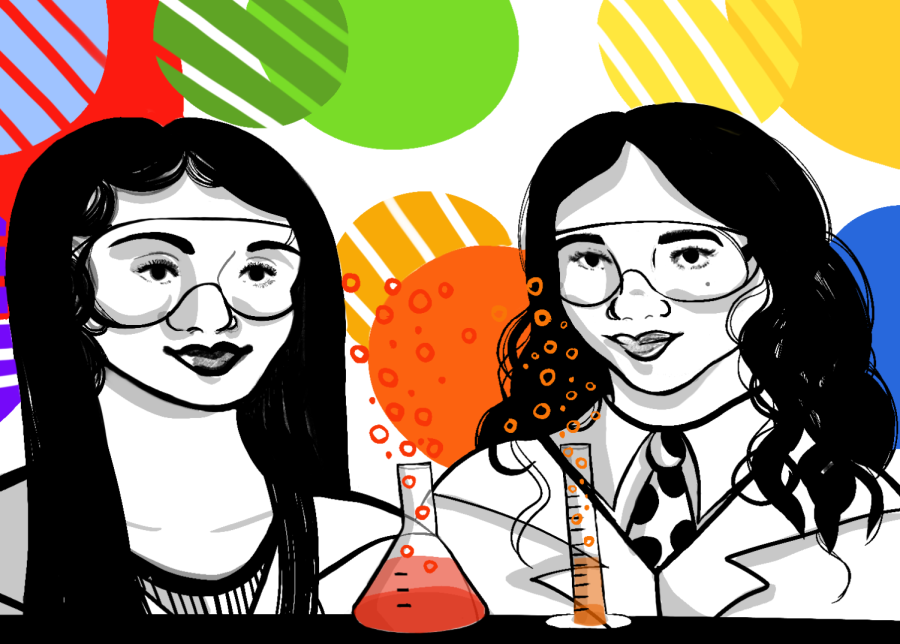Latinas in STEM: Defying the Representation Gap
Castaic students speak up about their experience being Latina and pursuing a career in STEM, highlighting the inequality that has already plagued their journeys.
December 10, 2022
Latinx representation in the media and the workforce has been a lacking source of inspiration for young Latinx individuals. For Latinas especially, ethnic and gender underrepresentation in the STEM field intersect and compound the number of obstacles they face.
“I’ve definitely faced a lack of motivation sometimes due to a lack of representation of Latinas in STEM,” said Isabel Vasquez, a junior who is working towards a career in engineering.
While the representation of women varies across STEM careers, they remain underrepresented in certain job clusters, such as physical sciences and engineering. This discrepancy is highlighted among the Hispanic working population in the United States, who make up 17% of total employment across all occupations, but just 8% of all STEM workers. While there has been a rise between 2012 and 2018 in the number of Hispanic students earning a bachelor’s degree in the STEM field, all STEM careers maintain a low Hispanic representation.
A 2021 survey conducted by Pew Research assessed how people perceived Hispanic achievement across several different occupational groups. The results revealed a divided sentiment between male and female Latinos. 59% of Hispanic men held an optimistic view of the achievement level of Hispanic engineers compared to 48% of Hispanic women. Likewise, a higher percentage of Hispanic men rated engineers as accommodating to Hispanic workers compared to women.
This trend is not a coincidence, but rather a result of an accumulation of social and environmental factors that contribute to the underrepresentation of women in STEM. The intersectional inequality Latinas in STEM face compounds the issue even further. Latina, Black, and Indigenous women represent less than 10% of the STEM workforce while making up 17% of the total U.S. population.
“Sometimes it can feel as if my journey in STEM will be harder because of my ethnicity,” adds Vasquez. Natalie Almeida, a junior at CHS, agrees, stating that being a Latina in STEM “has brought forth challenges… such as inferiority in a working environment…”
While the low pay (relative to their male counterparts) and long hours that may interfere with familial responsibilities may be the deterring factor for some women, the culture surrounding women in STEM is the primary barrier to entry into the field.
“You’re in a culture where, on any given day, somebody might think you were a secretary or a janitor, or anything but a graduate student in physics,” said Evelyn Hammonds, the chair and professor of the history of science at Harvard.
As of 2021, women only constitute 27% of the science and engineering workforce. This disparity stems from the elementary years. A 2010 report compiled eight research findings that prove that social and environmental causes are the root of the lack of representation of women in STEM. Despite several studies suggesting that women’s test scores are improving significantly in comparison to men, the number of women navigating into the field is not proportional to that growth.
Research profiled in the report by Shelley Correll, a sociologist at Stanford University, verified that girls evaluate their own abilities more harshly, hold themselves to a higher standard, and show less interest in pursuing a career in a profession where male superiority is prevalent.
Joshua Aronson, an associate professor of psychology at New York University, states that girls perform more poorly than boys as they advance through school because of the “stereotyping that kids are exposed to—in school and the media and even in the home—that portrays boys as more innately gifted [in math].”
“Especially in the face of my family members, peers, and friends, I always have felt the need to disprove everyone’s assumptions about me,” said Amber Hernandez, a Mexican-American student at CHS. “This has allowed me to go above and beyond in many aspects of the workplace.”
Stereotyping and self-assessment are directly linked. Correll refers to stereotypes as “cognitive crutches” in situations where people have little to no experience. And despite not endorsing a stereotype, such as that men are better than women at math, women expect to be treated as “less than” when surrounded by a culture that perpetuates the stereotype. This expectation degrades a person’s self-assessment.
Correll’s 2001 study revealed that the likelihood of enrolling in high school calculus and selecting a quantitative college major increased when students of equivalent ability had more positive self-assessments. In her sample, she discovered that males were 1.2 times more likely to enroll in calculus than their equally skilled female peers.
Undoubtedly, stereotypes are tainting women’s self-assessment from a young age, inhibiting them from choosing a career in STEM.
For Latinas especially, lack of representation in the media and in mentors exacerbates the issue of stereotyping and degrading self-assessments.
In Hollywood, Latinas are often portrayed to fit the box of the “Spicy Latina,” a hypersexualized, confrontational, and hot-blooded character. Rarely do young Latina girls have the chance to see successful and intelligent role models with similar backgrounds on screen to look up to.
When asked how a lack of representation has personally affected her, Vasquez said the lack of role models “can definitely be discouraging. Growing up, I never really had a role model on TV with my background or a mentor to look up to. I’ve never had a Hispanic STEM teacher, and that can definitely feel isolating.”
Vasquez is not alone. 81% of Hispanic Americans say that young Hispanic people would be more likely to pursue a STEM degree if they had examples of high achievers in the field who are Hispanic.
“I’ve recently gotten into STEM and I just joined the science olympiad club this year,” recounts Maya Guiza, junior. “Before this year, all of my STEM classes have been taught by male teachers. I’ve never had a female or Latino math teacher. This has made it so that science and STEM opportunities seem far-reaching. It seems harder to get there when I don’t see anyone that represents me.”
Additional stereotypes of Latinas in television include low intelligence, lack of education, inarticulate speech, laziness, and verbal aggression. Their roles are largely limited to prostitutes and maids. The effects of this are detrimental. Non-Latino individuals may submit to judgments of Latinos curated by the media, especially if the skewed representation they see on television is their only exposure to Latinx characters. This portrayal also inadvertently leads to low self-esteem in Latina viewers.
On the flip side, Hernandez has personally experienced the benefits of positive representation. “My grandma, Abuela, and mother all understood the impact which my heritage had on me, so they provided as much love and resources that they could obtain in their circumstances. This love and education grew into a well-rounded understanding and open mind of a variety of cultures, and spiked my curiosity to discover more about the world around me.” With an abundance of Latina role models and powerhouses to look up to, Hernandez grew up with support and leaders that helped guide her into her STEM passions.
The issue of representation extends to the classroom. A recent NYC study found that although 85% of NYC’s public schools are composed of non-white students, most elementary school books did not include work by people of color or featured characters of Black, Asian, or Latin descent.
Teachers at CHS are tackling the issue one student at a time. When asked how he encourages students to become more involved in the STEM field, Patrick Lechuga, a geometry and AP computer science teacher, said “I request certain students I see in geometry classes that I think would be a good candidate for AP Computer Science Principles and I will encourage them to take the class.”
From personal experience, Lechuga noticed that mentors have the power to catalyze more students to pursue a certain field. “Even at the small school I went to there weren’t any professors I knew that were of Latin descent or minorities. For me, the more you can connect with a professor through the experience that Latinos go through, the more that you’re gonna be able to be inspired.”
In her classroom, Lisa Soares, a Spanish teacher at CHS and the advisor of the Latinx Culture Appreciation Club, works to ensure every student feels acknowledged. “I know that when I’m doing representation stuff on my Google slides when I’ve got pictures with vocab, I try to choose people from different areas of the world so that people can see themselves reflected. Like, when it’s a doctor, I make sure I have a person of color that’s represented there, too.”
When students see themselves represented, it promotes positive identity formation and makes them feel like valued members of society. Whether in books, TV shows, or in real life, representation encourages students to pursue their passions.
“…to many, it can come as a surprise when such a small, quiet, ‘Mexican’ girl that sits in the back of class holds so much information,” adds Hernandez. Dismantling the stereotypes and negative expectations of Latinas in STEM begins in the classroom.
Through representation and encouragement, Latinas are bound to find themselves in a greater state of empowerment to conquer the obstacles that come with pursuing a career in STEM. To eliminate barriers in the classroom, it’s up to teachers to ensure their students feel inspired, empowered, and represented.
How to Help
The Latinas in STEM Foundation was founded in 2013 by first-generation Latina MIT alumnae. They aim to mitigate barriers to entry for women in STEM fields and are dedicated to inspiring and empowering Latinas in communities of need through volunteer-led and run organizations that host mentorship, networking, and recognition events nationwide. The Latinx Culture Appreciation Club at Castaic High School has partnered with the organization to fundraise for their cause.
The club’s goal is to raise $500 by Jan. 1, 2023. All proceeds will go directly towards funding STEM 101 workshops for Latinas in underserved communities.
Beneath the surface, however, the fundraiser targets a much more ingrained and systematic issue: representation— or lack thereof.
By allocating resources and guidance to Latinas in communities of need, the Latinas in STEM Foundation is fostering a future generation of Latina role models that defy the stereotypical mold.
To donate, please click here. If you’re interested in joining the Latinx Culture Appreciation Club, contact president Fernanda Matias at [email protected].







Patrick Lechuga • Dec 7, 2022 at 7:59 am
Excellent article!